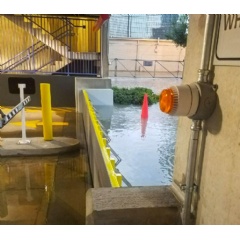An Introduction to Flood Protection: Defining Wet and Dry Floodproofing, Active and Passive Systems
As part of a series of posts related to An Introduction to Flood Protection: What Owners Need to Know to Protect Their Properties by Doug Coenen and Ray Drexler, this article examines Wet versus Dry and Active versus Passive flood protection systems.
Wet Versus Dry
FEMA Manual 551, “Selecting Appropriate Mitigation Measures for Floodprone Structures,” defines wet floodproofing as:
“Permanent or contingent measures applied to a structure and/or its contents that prevent or provide resistance to damage from flooding by allowing floodwaters to enter the structure.”
In a wet flood proofing system, the structure and contents are designed to get wet by floodwaters. This is typically less costly than dry floodproofing because the internal and external hydrostatic pressures tend to equalize, lessening the loads on the structural elements such as walls, floors, and columns. The architect and engineers design the structure with intent to flood and, after a brief cleanup, return to normal operations. Where this method is considered, it is important to understand the code and insurance implications and the impact to operations. The materials used should be water resistant and electrical and mechanical systems must be isolated and protected. The cost of cleanup should be part of the consideration for using this method. The disadvantages to this approach are potential chemical/ sewage contamination cleanup issues and structural damage that can occur if unbalanced loads occur with floodwater inflow or removal, high velocity waterflow, or wave action. Additionally, MEP damages can occur if the systems are not designed for unattended wetting and drying cycles—for example, biological growth in ducts. Isolation of the flooded areas from the rest of the building need to be considered.
FEMA Manual 551 defines dry floodproofing as:
“Measures that eliminate or reduce potential flood damage by keeping floodwaters out of the structure.”
Dry floodproofing is accomplished by either making the structure watertight below its design flood protection elevation, or by building an exterior protective barrier and accommodating rainfall that falls behind the barrier. Dry floodproofing is the more common flood protection application.
Active Versus Passive
Dry floodproofing can be either an active system, meaning human interaction is required to activate or deploy the system, or a passive system, meaning no human interaction is required to activate or deploy the system. All floodproofing designs will have common measures, whether they are active or passive systems. What makes them active typically is that there is some portion of the system such as a flood door or other operable barrier element that requires someone to secure it. When a structure can be adequately strengthened to resist the design flood loads, the work can be limited to the existing building footprint and additional impacts to the site may not be required. However, if the structure cannot be adequately strengthened, protection may take the form of an exterior barrier. The exterior barrier requires a way to drain behind the barrier and floodplain mitigation may be necessary to offset lost floodplain storage. The exterior barrier could have a significant impact on the site.
An example of an active system is a system that uses a manually activated flood gate. Gates, doors, vent covers, flood logs, flood panels, and sandbags are some of the active measures typically employed. Any system with elements that have to be activated to seal breaches falls into the active protection category regardless of other passive components. A passive system is one that self-deploys every time it is needed or one that is permanently deployed such as a wall or berm. These are typically elements that float up into place as the water rises or are permanent barriers without moving parts that prohibit water intrusion. Mechanical closing systems are available, but are discouraged since the protocol to activate remotely does not typically allow for addressing issues at the enclosure location which is a critical failure in the system. The costs associated with a passive system can be comparable to an active system that requires human activity for deployment, but some of the passive system measures can have consequences that need to be considered and may not work in all situations.
A float up gate is an example of a passive system. The gate is designed so that rising flood water lifts the gate regardless of human interaction. This is the inherent advantage of a passive system—the rising water deploys the system, regardless of the time or who is at the facility, provided it has been properly maintained. These systems can be operated manually as well to take away the potential of an issue at the time of the flood, so they can be managed as active systems, but have the passive action as a backup.
Download An Introduction to Flood Protection: What Owners Need to Know to Protect Their Properties.
Doug Coenen, PE is a Principal and the Civil Engineering Business Development Manager in Walter P Moore’s Infrastructure Group.
Ray Drexler, PE is a Principal and Senior Project Manager in Walter P Moore’s Diagnostics Group.
( Press Release Image: https://photos.webwire.com/prmedia/7/281112/281112-1.jpg )
WebWireID281112
This news content was configured by WebWire editorial staff. Linking is permitted.
News Release Distribution and Press Release Distribution Services Provided by WebWire.
